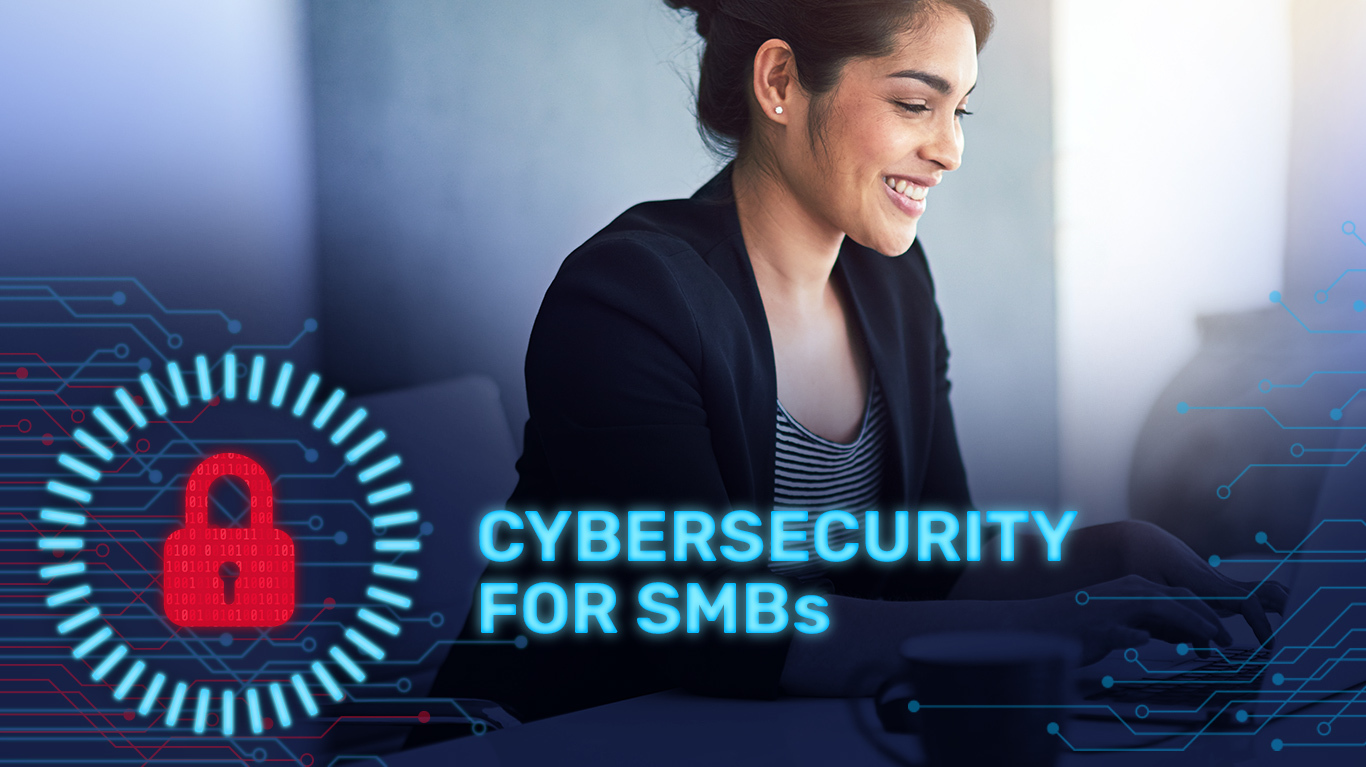This blog is part 1 of our 4 part Cybersecurity for SMBs series.
In the wake of an increasing number of high-profile data breaches, businesses of all sizes are doubling down on cybersecurity efforts. However, with a limited budget compared to enterprise-level organizations, small to medium-sized businesses (SMBs) need to be calculated and prudent with their cybersecurity strategy.
As an SMB, deciding to invest in a customized security service might seem like overkill at the time, however, the value will become apparent when your tailored cybersecurity plan proactively thwarts a cyber attack that could have been the catalyst to your business’s early demise.
Why Your SMB is a Top Target for Cyber Attacks
To clear up any misconceptions, cybersecurity for SMBs encapsulates the software and monitoring that protects a business’s email, operating system, network, and printing devices from malicious attacks or data theft in tandem with employee cybersecurity training, ransomware awareness, and a robust business continuity and disaster recovery (BCDR) plan.
Hopefully, cybersecurity isn’t a new concept for your business. If it is, there is a chance your business is a prime target for hackers waiting for the perfect opportunity to strike. While large enterprises continue to increase cybersecurity spending, hackers and cybercriminals are wasting no time by pivoting to smaller, weaker targets: SMBs. Though small to medium-sized businesses are beginning to invest in digital security, they remain targeted due to a shortage of resources to defend against malicious cybersecurity attacks.
This unfortunate trend is reflected in the statistics.
According to Verizon’s Data Breach Investigations Report, 43% of cyber attacks target small businesses. When coupled with the alarming statistic that 83% of SMBs feel unprepared for a ransomware attack, it becomes clear why hackers are jumping at the opportunity to target SMBs.
To prevent your business from becoming “just another statistic,” SMBs should partner with a managed IT service provider to create an extensive and tailored cybersecurity strategy that secures business-critical information and enables greater employee productivity for remote and in-house personnel.
Components of an Extensive Cybersecurity Strategy for SMBs
With a bullseye on their back, it is imperative that SMBs quickly implement a tailored cybersecurity plan that secures their IT end-points and seals off any vulnerable backdoors that could be exploited to launch cyber attacks. A comprehensive cybersecurity strategy customized to the unique security needs of a business’s IT infrastructure proactively protects, detects, and responds to cyber threats in real-time to dissipate IT headaches so businesses can focus their limited budget and valuable time on growing business operations.
Protection
A complete cybersecurity plan for SMBs includes combining specific hardware, software, and processes to sufficiently protect against cyber threats. Managed cybersecurity services optimize an organization's current security infrastructure and cybersecurity processes with advanced threat protection features. These features can include:
Consistent Security Assessments - SMBs are often challenged with prioritizing and implementing their cybersecurity efforts, especially as their business scales. Proactive and regular security analysis is leveraged to evaluate internet infrastructure vulnerabilities and provide specific security recommendations to enable a secure, reliable, and compliant network.
Up-to-date Antivirus Software - Advanced and effective antivirus software detects, removes, and protects against malicious software, including viruses, trojans, worms, spyware, and adware.
Cloud Security - SMBs that utilize cloud applications such as storing cloud backups need to include cloud security in their cybersecurity strategy. The right managed service provider (MSP) provides SMBs industry-certified engineers with 24/7 cloud support, ensuring business continuity at all times.
End-User Training and Testing - An all-encompassing cybersecurity strategy for SMBs includes cybersecurity training and testing to ensure businesses and employees can protect themselves from malicious cyber attacks. An effective internal cybersecurity training program includes:
- On-demand video training modules
- Phishing attack simulations
- Automated training enrollment for employees
- Detailed real-time reporting and analysis of employee training results
Detection
Another critical element of a bolstered cybersecurity plan for SMBs is detection. Without advanced cybersecurity detection capabilities, a business will be unable to respond and plan an efficient recovery strategy if and when a cyber breach occurs. Here are some of the cybersecurity detection features included in a comprehensive cybersecurity strategy.
Next-Generation Firewall (NGFW) - Next-generation firewalls go beyond the traditional monitoring and filtration capabilities and include additional security features such as firewall VPN, app control, and intrusion prevention.
Regularly Scheduled Vulnerability Scanning - Vulnerability scanning is a cybersecurity detection process that ensures hardened end-to-end security across all networks, devices, and platforms. Advanced network monitoring software and tools are leveraged to provide security support for:
- Network infrastructure
- Workstations
- Routers
- Servers
- Applications
- Print Environment
Response and Recovery
A reliable end-to-end cybersecurity plan is incomplete without a flexible and proactive business continuity and disaster recovery (BCDR) plan to avoid any potential data loss in the case of a successful cybersecurity attack. A robust BCDR solution will have the capability to provide on-premise recovery for a small localized event, such as a hardware failure or ransomware attack, and complete disaster recovery in the cloud in the case of a catastrophic event.
MSPs report that the average cost of downtime due to ransomware has increased from $46,800 to $274,200 over the past two years. The increased cost of downtime is a bill most SMBs simply cannot afford.
In addition to reducing downtime in the case of a security breach or emergency, businesses that partner with a trusted BCDR service provider will reduce their overall financial liability, ensure regulatory compliance, and quickly and efficiently restore business-critical information with minimal disruption.
Keep Your Business Protected with a Proactive Cybersecurity Strategy
Cybersecurity risks continue to grow in frequency and severity while disproportionately targeting less prepared small to medium-sized businesses. A managed end-to-end cybersecurity and data protection service for your SMB will identify critical areas of vulnerability and proactively remediate issues before they chip away at your bottom line.
SMBs ready to successfully combat cyber-attacks should strategically partner with the right managed security service provider to implement a tailored managed IT service that reduces the likelihood of data breaches from occurring and enables businesses to scale with confidence.




